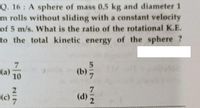Question

Transcribed Image Text:Q. 16 : A sphere of mass 0,5 kg and diameter 1
m rolls without sliding with a constant velocity
of 5 m/s. What is the ratio of the rotational K.E.
to the total kinetic energy of the sphere ?
(b) 7
(a)
10
7
(d) 2
5I7
NIN
Expert Solution
This question has been solved!
Explore an expertly crafted, step-by-step solution for a thorough understanding of key concepts.
Step by stepSolved in 2 steps

Knowledge Booster
Similar questions
- A flywheel is a solid disk that rotates about an axis that is perpendicular to the disk at its center. Rotating flywheels provide a means for storing energy in the form of rotational kinetic energy and are being considered as a possible alternative to batteries in electric cars. The gasoline burned in a 270-mile trip in a typical midsize car produces about 1.64 x 109 J of energy. How fast would a 11.4-kg flywheel with a radius of 0.238 m have to rotate to store this much energy? Give your answer in rev/min.arrow_forwarda 7kg solid sphere rolls without slipping on a horizontal surface with its center of mass moving at 5m/s. what is the ratio between the translational and the rotational kinetic energies?arrow_forwardT m A 25.0 kg mass is hung from a rope that is passed over a pulley and held by a man standing on a ramp. The pulley can be treated as a solid disk with a mass of 10.0 kg that has a radius of 0.400 m. The man pulls the rope so that the pulley rotates from rest through an angular displacement of 15.0 rad in 2.00s. A. What is the angular acceleration of the disk? B. What is the tension of the rope as it pulls up on the box? C. What is the force applied by the man on the rope as he pulls the box upward?arrow_forward
- Can you help me with this physics problem please? On a xy plane, there are three masses are attached rigidly to a ligt board. There is a 5 kg mass at (-4m, 5m), a 2 kg mass at (0,-2m) and a 3kg mass at (3m,0). It is rotating around the x axis at 1.75 rad/s. What is the rotational kinetic energy?arrow_forwardA flywheel is a solid disk that rotates about an axis that is perpendicular to the disk at its center. Rotating flywheels provide a means for storing energy in the form of rotational kinetic energy and are being considered as a possible alternative to batteries in electric cars. The gasoline burned in a 131-mile trip in a typical midsize car produces about 3.01 x 10 J of energy. How fast would a 38.5-kg flywheel with a radius of 0.597 m have to rotate to store this much energy? Give your answer in rev/min. Number i jud eTextbook and Media Units >arrow_forwardA solid 0.6150 kg ball rolls without slipping down a track toward a vertical loop of radius ?=0.7350 m. What minimum translational speed ?minvmin must the ball have when it is a height H=1.111 m above the bottom of the loop in order to complete the loop without falling off the track? Assume that the radius of the ball itself is much smaller than the loop radius ?R. Use g=9.810 m/s^2 for the acceleration due to gravity.arrow_forward
- A 4 kg ball with a 0.5 m radius rolls at a constant 4 rad/s. The rotational inertia of the ball is 0.5 mr2. What is the total energy of the ball?arrow_forwardA flywheel is a solid disk that rotates about an axis that is perpendicular to the disk at its center. Rotating flywheels provide a means for storing energy in the form of rotational kinetic energy and are being considered as a possible alternative to batteries in electric cars. The gasoline burned in a 187-mile trip in a typical midsize car produces about 2.84 x 109 J of energy. How fast would a 9.42-kg flywheel with a radius of 0.237 m have to rotate to store this much energy? Give your answer in rev/min.arrow_forward
arrow_back_ios
arrow_forward_ios